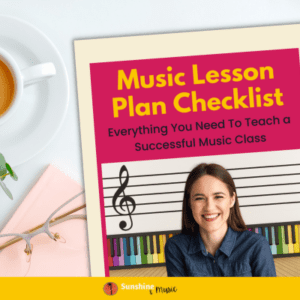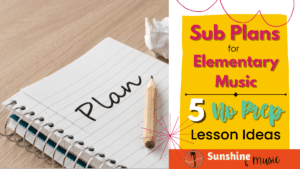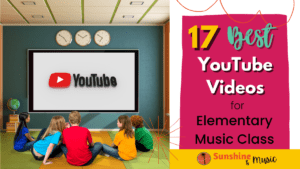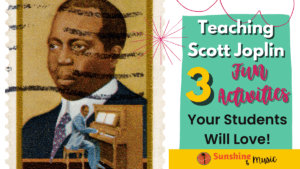A couple weeks ago, I started a series – Getting Started on Gordon, to introduce Music Learning Theory to teachers. You can check out the first parts here:
Getting Started with Gordon – Intro
Getting Started with Gordon – Learning Levels
Getting Started with Gordon Demo Video
Today I’m going to talk about the last two levels of discrimination learning – Symbolic Association and Composite Synthesis. So again – discrimination learning is basically about teaching the kids basic musical facts.
Symbolic Association – This is the level where kids get to see music written in notation.
Composite Synthesis – This is when students can look at notation and understand it in context (ex – This song is in minor and it is duple meter). I may be wrong in this, but I believe that they should be able to audiate it too (ex – look at a song in notation and realize it is Happy Birthday. Or on the simpler end: Look at a rhythm pattern in duple meter and realize it’s duple and be able to read it in their head).
One thing that is important to remember about written notation is that it is a spiral. You will keep coming back to it. So for example, my second graders might be at Composite Synthesis with duple rhythm patterns, but are still on Verbal Assocaition with DO-RE-MI patterns.
So lets see how we would add these things into an actual music class …
RHYTHM
Now that we’ve laid down the basics about rhythm in the earlier levels (saying them, labeling them, understanding them in context) we can show them in notation with much better understanding and connection. So usually, for me symbolic association started with echo-me flashcards. I show it too them, I read it to them, them echo. Then, when that is good, I show it to them, they audiate the pattern, then they say it out loud. Finally, I may challenge them to read it outright, with no practice it in your head audiation round beforehand. I move RIGHT from reading into writing. I feel like these are super duper linked – two sides of the same coin. I ordered whiteboards from US Toy for cheap and we use them all the time for rhythm writing. Saves me so much paper! I may start out by just having them copy the notes we are learning (draw a quarter note or a rest, etc). Then I will SAY a rhythm and they will dictate it. Then, we compose our own songs. I have a Composer Fair every year at my school where our final projects are displayed.
SPIRALING
Please, please remember that you don’t have to teach your kids every rhythm under the sun by ear before they read anything. So for example, my first graders learn to READ quarters, paired eighths and rests, but they are echoing 16th notes at aural/oral – with no syllables yet. Over the years we are introducing things in that sequence, and by 4th grade they will be at symbolic association and composite synthesis with 16th notes.
As I am writing this, I am thinking, okay, well when does it turn from symbolic association to composite synthesis? For reading, I would say when they are echoing you it is symbolic association, and when they are reading alone it is then composite synthesis. I mean technically to check you should also ask them what the meter is, I suppose. With writing, I would say that the transition happens when they go from copying you to dictating on their own and composing on their own. Again, the useful part of MLT is knowing what is happening internally in each stage of learning, so you can fill in any gaps – especially when you see your kids failing at something and need to know where to backtrack to put them on the right course. So do you REALLY need to worry about what is Symbolic Association stage and what is Composite Synthesis? Not really. You just need to know that kids may need to echo-read with your help before you pull the training wheels off and have them do it themselves.
TONAL
When teaching note reading, I start with echoing flashcards again. Then we go to audiate, then sing (not always perfect at first, but actually often pretty decent. I sing them the correct answer if they mess it up). Finally, we read/sing right away (small patterns). I start with just SO-MI patterns, then add LA, then DO-RE-MI. This is not really 100% MLT, but it IS what my state benchmarks tell me to do, so it’s one of those compromises. I believe that pure MLT would start with tonic and dominant patterns (ex DO-MI-SO, SO-MI-SO, SO-RE-SO, TI-RE-FA), just in case your were wondering. The reasoning (or my best guess at it because I really am not an MLT guru): 1) students first learned about major by listening to tonic and dominant patterns during Learning Sequence Activities 2) they are trying to build knowledge of chord structure, versus individual intervals.
So with singing, that spiral teaching that I talked about really comes through again. According to my state benchmarks, kindergarteners are supposed to learn to read SO-MI patterns. Since my kiddos aren’t really even at verbal association with solfege yet, I have to do a mini spiral where we learn those two names. First we just sing them on “high” and “low”. Then we give them names (SO-MI) and echo. Then we sing. Yeah, not perfect, but I’m just trying to meet my benchmark while keeping a little integrity in my teaching. I don’t grade too harshly, and I consider it sort of an introduction so we can jump back into it in first grade.
In first grade and second grade we are in verbal association, so it is easier to make a quick spiral back in to teach SO-MI-LA patterns through echo-reading. But it isn’t until 3rd grade that we get serious about note reading, because by then they have really had the chance to cover tonality (partial synthesis) and understand notes based off the resting tone. We really focus on MI-RE-DO at the end of second grade and going into third, since we will start to read notes and then transfer them on to recorder. We also start to move DO around. I make sure to talk a lot about how DO can be any note, but on recorder G is an easy key, so we make G DO. But when we get on the xylophones, maybe C is DO.
Just like the whiteboards with my rhythms, I use big, laminated staffs and bingo chips to teach staff notation. In K – we create SO-MI patterns with partners. In first grade we add LA. In second we start to focus on MI-RE-DO. In third we start to talk about note names (BAG). In fourth I normally would add FA, but I am thinking of adjusting this, since 3-5 grade note reading is linked to recorder playing, and usually I go from BAG to CD, but now am thinking of going from BAG to low DE to encourage gentler playing and to talk about minor tonality. In fifth grade, we learn ALL the notes of the staff and explain ledger lines.
SO hopefully this gives you some ideas of how you can create successful note and rhythm reading in your classroom. Please stay tunes for some specific lesson ideas as I continue this series. And please feel free to post any questions or message me! Happy teaching!







0 Responses